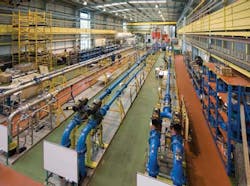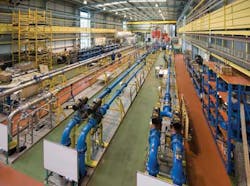Diagnostic tools can help streamline meter calibration process
Craig Marshall
NEL
Government and regulatory bodies require calibration of flow measurement devices. The costs for such calibrations are commonly assumed to be in the region of $50,000 or more.
The goal for any meter manufacturer, operator or service provider is to have a calibration- free instrument. Aside from the cost savings, this would bring benefits such as improved measurement confidence and reduced downtime.
While flow measurement devices are not quite at the calibration-free stage as yet, the use of secondary diagnostics is enhancing metering capabilities. In addition to providing qualitative information about the measurement method, these diagnostics can offer an insight into the dynamics of the flowing fluid. By monitoring and analyzing the diagnostics over time, users can provide regulators with information on the present state of their meters, with the aim of reducing the need for recalibration.
Modern flow meters can record and store a vast amount of flow measurement-related data. Additionally, digital signal processing enables more information to be obtained. This has allowed detailed monitoring of all recorded data to be used as diagnostic tools to identify any problems within the metering system and to complete a "health-check" of the meter in operation.
Traditional flow meters have also been adapted to deliver these benefits. However, the diagnostics are not generated as a consequence of the primary measurement, but employ additional measurements in combination with the primary flow data to provide further information about the performance of the measurement system. Due to the large volumes of diagnostics available, it is essential that they are used or analysed correctly. If not, mistakes will more likely be made when interpreting the data.
Operating procedures
As software can provide indications of problems with the metering package or process stream, so diagnostics are being used to give a qualitative indication of how metering systems are operating. If measurements exceed accepted levels, the system alerts an operator. These alarms can be time-dependent, which means any erroneous measurement will not be recorded as a fault until the software judges that the problem is real and not due to one instantaneous fault or error with the system.
Another successful application of diagnostic software is built-in remote access. Using a high-speed connection, the data produced from the meters can be accessed from anywhere in the world. This advantage cannot be overestimated, especially when multiple measurements are being taken over large distances or in harsh conditions. It may not be feasible to have experienced metering engineers at each metering location, and the ability to review meter diagnostics in comfortable company offices is extremely advantageous.
This diagnostic information, coupled with the remote access feature, is of particular interest to the industry as a detailed knowledge of how meters are operating gives confidence that the measurement systems are functioning as intended. Additionally, regular monitoring of these diagnostic parameters allows trending of the data over time. This information can then be used to provide evidence to support an extended interval between meter calibrations.
Confirming calibration
Use of secondary diagnostics can take us a step closer to calibration-free flow measurement devices. This is because taking a fingerprint of the diagnostic parameters during calibration can provide a traceable link to meter performance. Once the meter is installed for use in a process stream, the diagnostics can be checked to ensure there is no change or shift from the calibration, providing reassurance that the calibration is successfully transferred to the operating location and conditions.
The diagnostic parameters can then be monitored over time for any slight variations. If the diagnostics are shown to have no shift from calibration or installation fingerprint values, then the meter is still operating within the original calibration. Variables that are often the primary causes of meter shift, such as pipe roughness, deposition or electronic shifts, cannot have occurred as these will have had a noticeable adverse impact on the diagnostics.
To assist diagnostics analysis, many manufacturers have developed proprietary software that can produce automatically generated reports showing changes in diagnostics over set timelines, typically months or years. Using embedded technical knowledge gained from years of operational data, the software can suggest when calibrations are actually necessary. This is one of the first stages in moving from a calendar-based calibration interval to the more utopian approach of a condition-based one.
Evidence from Peterson, Lightbody and Trail's work ("Online Condition based Monitoring of Gas USMs," North Sea flow Measurement Workshop, 2008) shows that the technology works and by providing details of the diagnostic data to regulators, as evidence of continued performance, recalibration intervals can be extended. The length of extension will obviously vary with process conditions, i.e. the level of fluid cleanliness, but Hall, Zanker, and Kelner ("When Should a Gas Ultrasonic Meter be Recalibrated?," North Sea Flow Measurement Workshop, 2010) have shown that a gas ultrasonic flow meter kept its calibration for over six years. In recognition of this and other studies, International Standards are now advocating the use of diagnostics in measurement. One example can be seen in ISO 17089-1:2010, "Measurement of Fluid Flow in Closed Conduits – Ultrasonic Meters for gas – Part 1: Meters for Custody Transfer and Allocation Measurement."
As noted earlier, diagnostics can give qualitative information about the flowing fluid. Using this data and the embedded technical knowledge, the resultant flowrate information can be reassessed and a confidence level applied. However, there are some situations where knowing a problem exists is still not good enough, and diagnostics may again be used to help remedy the issue.
Meters are required to take measurements in increasingly difficult circumstances, i.e. two or three-phase flow, which often leads to problems with mismeasurement. In view of the significant financial exposure associated with inaccurate measurement, it is essential to improve current measurement practices to validate and include secondary flow information that can potentially help to resolve some of the measurement problems.
By employing additional measurement techniques in conjunction with other primary methods or secondary diagnostics, it may be possible to predict how much of a second phase is present. This effectively turns single-phase devices into two or three-phase meters.
Although this scenario may seem unlikely, recent test work completed at the UK National Standard Flow Measurement Facilities at NEL in Scotland, supported by the UK government's National Measurement System, shows promising results for ultrasonic meters tested with gas injection. Although issues remain with repeatability, there are definitive trends between diagnostic parameters and increasing gas volume fraction. By comparing the trends, corrections can potentially be created that can calculate gas content. This can be used to significantly reduce measurement error associated with gas entrainment in liquid flow.
Although skepticism persists in some quarters about diagnostics, there is evidence that these technologies can make a real difference, and end-users in the field are reaping the rewards. Understanding how to use diagnostics most effectively will surely become a priority for future developments in the flow metering space.
Offshore Articles Archives
View Oil and Gas Articles on PennEnergy.com

